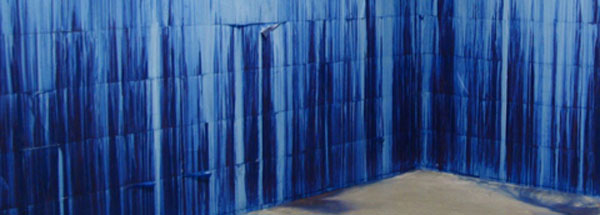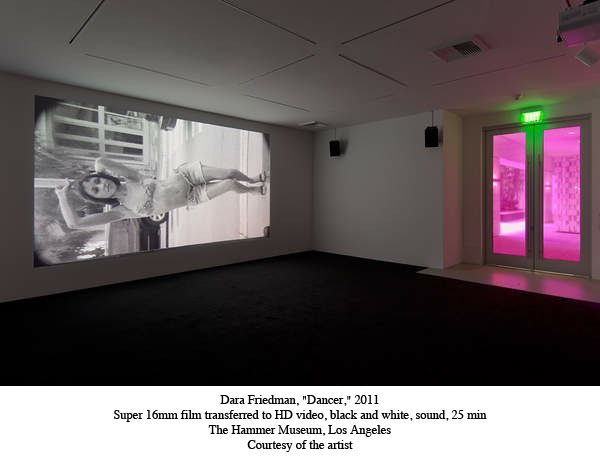

For the art aficionado, to discover even one truly good museum exhibition is a pleasure; but to stumble upon three intriguing and challenging exhibitions, all in the same place, is really something to celebrate. Right now, such a perfect trifecta of art exhibitions has taken over the main entrance, galleries, and seemingly all the nooks and crannies of UCLA's Hammer Museum.
Last week I talked about the Hammer's retrospective of tough-as-nails Los Angeles artist Llyn Foulkes, whose maddeningly complex multi-media paintings I described as "obsessive, nostalgic, tragic and very melancholic."

But there are two other fascinating exhibitions currently up at the Hammer, both equally engrossing and unconventional. The German-born, Miami-based artist Dara Friedman shows her black and white, 16mm film, Dancer. It's short -- only 25 minutes -- but it includes more than 40 segments of 60 different Miami dancers: running, jumping, heads spinning and, on occasion, even dancing en pointe.
And all that with the gritty streets of downtown Miami as their backdrop. I've seen it twice. The first time alone, the second with a bunch of friends who seemingly enjoyed it as much as I did. And you know what? I'm planning to be there again, to enjoy the syncopated rhythm of the segments as they cut from flamenco to modern, from ballroom to break-dance, from ballet to belly dancing.
It will be very interesting to see what Dara Friedman makes of her time spent here in Los Angeles as the Hammer's artist-in-residence, working on a follow-up film set against our City of Angels.
Meanwhile, the grand entrance to the museum, with its sweeping main staircase, is bleeding blue. And I mean that literally. Several thousand sheets of carbon copy paper cover the walls, floor to ceiling. But that is only the beginning of the story. Moroccan-born, Swiss-based artist Latifa Echakhch's installation feels like the aftermath of a huge storm that's left behind waterlogged debris -- blue ink dripping from the copy paper down the walls and pooling on and staining the floor. What we're actually witnessing is the aftermath of Echakhch's performance -- during which the artist splashed the carbon paper with paint thinner. As a result, the vast expanse of the lobby's walls turns into one gigantic color field or, if you prefer, abstract expressionist painting.
But beyond her Yves Klein blue, Echakhch's work makes specific political and cultural references. Her usage of once ubiquitous but now antiquated carbon copy paper is a reminder of how this particular material was used by both French bureaucrats in colonial North Africa as well as by protestors in the wake of the student riots of 1968, aiming to spread their revolutionary messages as cheaply and quickly as possible. To be completely honest, I have to admit that I enjoyed this blue storm on its own operatic terms; only later did I discover its embedded political meaning. And now I feel a little bit guilty for being seduced so easily and so completely by its bleeding beauty.
The Hammer's lobby has always been a stage for ambitious projects, but only a few of them, in their sheer imagination, can be compared with this current installation. More than 10 years ago, I remember being struck by the crazy, unruly, and delightfully messy spray paintings of German artist Katharina Grosse.
And last year, the same space was transformed yet again, by Barcelona-based Portuguese artist Carlos Bunga, who used his trademark combination of cheap cardboard, house paint and miles of packing tape to create three-dimensional architectural floor plans, with what look like references to ancient archaeological sites.
In a welcome coincidence, Carlos Bunga is currently exhibiting his new, equally theatrical work at Christopher Grimes Gallery in Santa Monica. This time, you can literally enter his temporary structure, imposing yet still obviously flimsy. And probably like myself, you will ask why his phantasmagorical, imperfect, and impermanent artwork lingers in your mind.
Banner image: Latifa Echakhch, À chaque stencil une révolution, 2007; Tate Modern, Bankside, London. Courtesy of the artist, Kamel Mennour, Paris and Galleria Francesca Kaufmann, Milan. © Latifa Echakhch
Edward Goldman is an art critic and the host of Art Talk, a program on art and culture for NPR affiliate KCRW 89.9 FM. To listen to the complete show and hear Edward's charming Russian accent, click here.
